Luck is not an option
Unless you're lucky enough to have landed the Wayne family enterprise as your benefactor, life in the non-profit arena is tough to put it mildly.
Non-profits are an essential contributor to the economy, making up between 5% and 6% of GDP, employess 11.9 million people in the US alone, and appear to be growing faster than most other sectors; however, this doesn't shield them from the lingering economic impacts of the pandemic and the runaway cost of living crisis.
These global issues resonate most with those non-profit organizations needing to fundraise to meet the increasing social responsibility they were designed to do.
As society continues to struggle with this new reality, so do non-profits – at a time when they are needed more than ever, donor numbers are down, volunteers are harder to recruit and retain, and competition grows.
So, in this fiercely competitive sector, how can non-profits streamline their operations while giving them the best chance to compete and reducing administration time?
The answer lies in Key Performance Indicators (KPIs), or more importantly, a set of predesigned KPIs for non-profit organizations to streamline their operations, reduce administration time, increase retention rates, and stay competitive.
What are Non-profit Key Performance Indicators?
KPIs, or key performance indicators, are measurements that gauge an organization's ability to accomplish its mission. Non-profit metrics quantify the organization's many endeavors in extending its impact on society. The spirit of KPIs generated for a non-profit organization is not unlike that of a for-profit business. Both structures aim to claim a more significant market share; however, most non-profit businesses develop KPIs that measure societal influence instead of revenue.
What Non-profit challenges do these KPIs aim to address?
Non-profits face unique challenges that require a different approach than for-profit businesses, as Non-profits must focus on their mission and impact on society rather than revenue.
Limited funding: Non-profits often struggle to secure enough funding to cover their expenses and achieve their goals.
Donor retention: Non-profits must retain donors to maintain a steady funding stream. However, many donors only give once and never return.
Volunteer recruitment: Non-profits rely heavily on volunteers to carry out their mission. However, recruiting volunteers can be challenging, especially for smaller organizations.
Volunteer retention: Once volunteers are recruited, non-profits need to keep them engaged and motivated. However, volunteers may lose interest or become disengaged over time.
Financial management: Non-profits must manage their finances carefully to ensure they use their resources effectively and efficiently. However, financial management can be complex and time-consuming.
Fundraising: Non-profits need to raise funds to support their mission. However, fundraising can be difficult, especially for smaller organizations that lack the resources to mount large-scale campaigns.
Marketing: Non-profits need to raise awareness of their mission and attract donors and volunteers. However, marketing can be expensive and time-consuming.
Competition: Non-profits often compete with other organizations for funding, volunteers, and attention. This can make it difficult to stand out and achieve their goals
The 8 Non-profit KPIs
In no order of importance, these KPIs are designed to deal with different aspects and address most non-profits' challenges.
Donor Retention Rate
A percentage figure of donors who continue to donate to your non-profit over a period of time. This KPI should be tracked monthly.

Why track it?
Donors are the backbone of non-profit organizations; keeping them engaged is essential for the organization's success. By tracking the Donor Retention Rate, non-profits can identify areas where they must improve their donor management efforts. For instance, if the Donor Retention Rate is low, it could indicate that donors are not given enough opportunities to contribute or are not being recognized for their efforts.
By addressing these issues, non-profits can improve their Donor Retention Rate and keep their donors engaged and motivated. This, in turn, can lead to better outcomes for the organization and the community it serves.
The formula is:
Donor Retention Rate = ((Number of Donors at End of Period - Number of New Donors) / Number of Donors at Start of Period) x 100
Donation Conversion Rate
The percentage of website visitors who make a donation. This KPI should be tracked monthly.
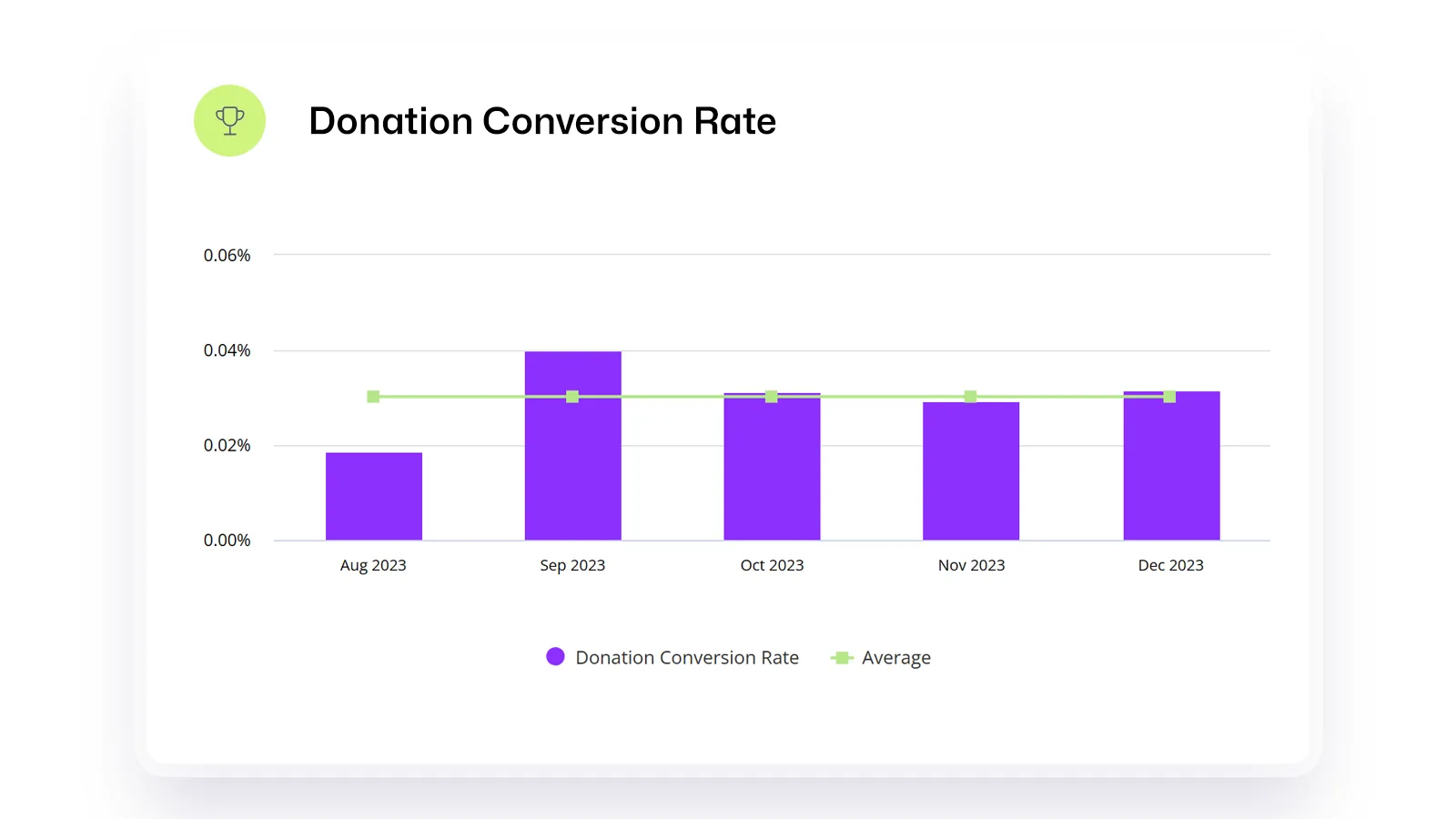
Why track it?
Tracking Donation Conversion Rates is an essential KPI for non-profits to measure their performance in converting more donors.A high Donation Conversion Rate indicates that the organization is doing a good job motivating people to give and follow through with the donation process. By tracking this KPI, non-profits can identify areas where they need to improve their donation management efforts. For example, if the Donation Conversion Rate is low, it could indicate that the donation page is not compelling enough or that the donation process is too complicated.
The formula is:
Donation Conversion Rate = (Number of Donations / Number of Website Visitors) x 100
Volunteer Retention Rate
A percentage of volunteers who continue volunteering for your organization over time. Typically, This KPI should be tracked monthly.
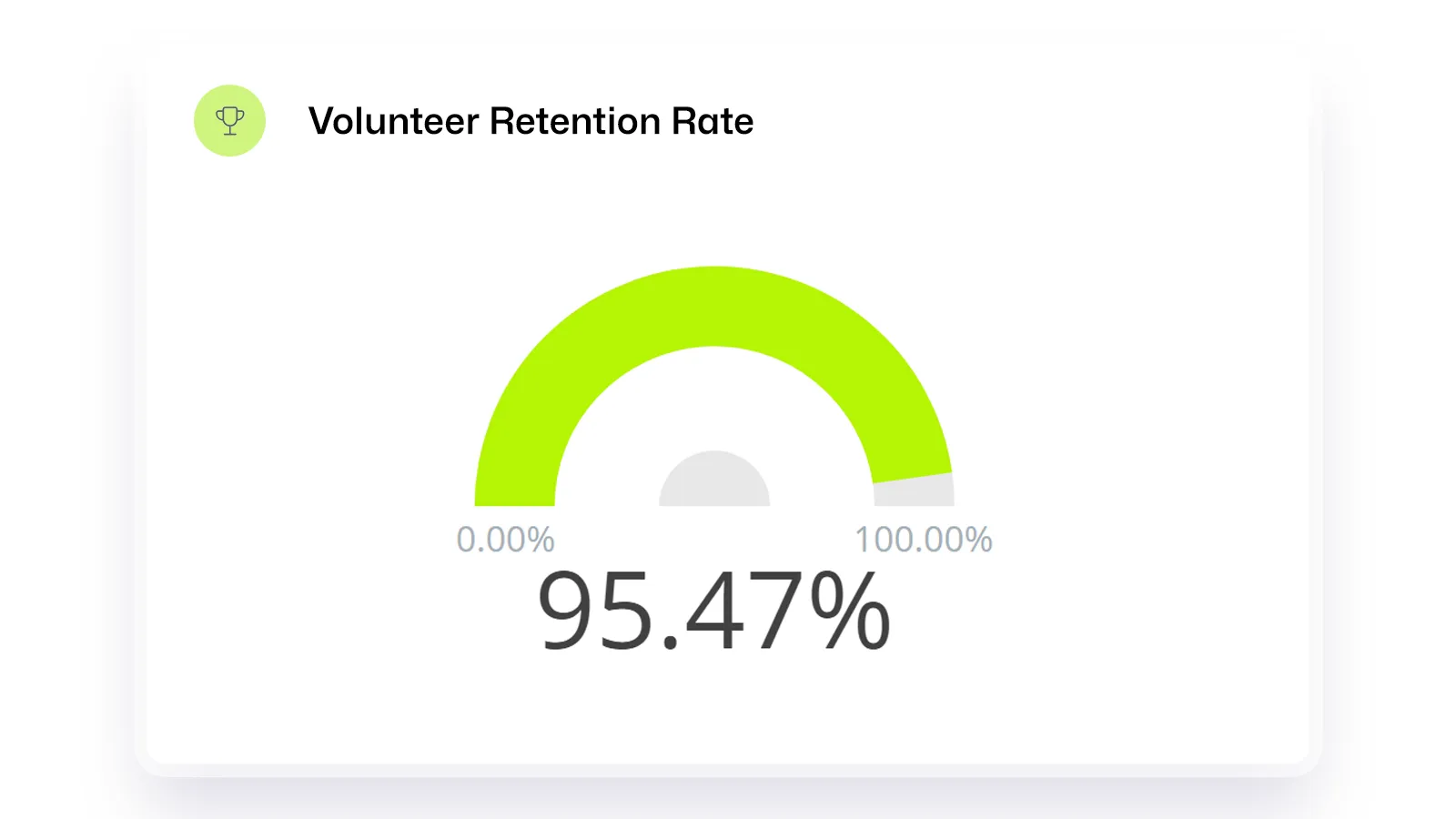
Why track it?
Tracking the Volunteer Retention Rate is an essential KPI for non-profits to measure their retention performance. Volunteers are the backbone of non-profit organizations; retaining them is crucial for the organization's success. By tracking the Volunteer Retention Rate, non-profits can identify areas where they should improve their volunteer management efforts. For example, if the Volunteer Retention Rate is low, it could indicate that volunteers are not given enough opportunities to contribute or are not being recognized for their efforts.
The formula is:
Volunteer Retention Rate = ((Number of Volunteers at End of Period - Number of New Volunteers) / Number of Volunteers at Start of Period) x 1000
Volunteer Satisfaction
The percentage of volunteers who report being satisfied with their experience volunteering for your organization. This KPI ideally should be tracked quarterly.
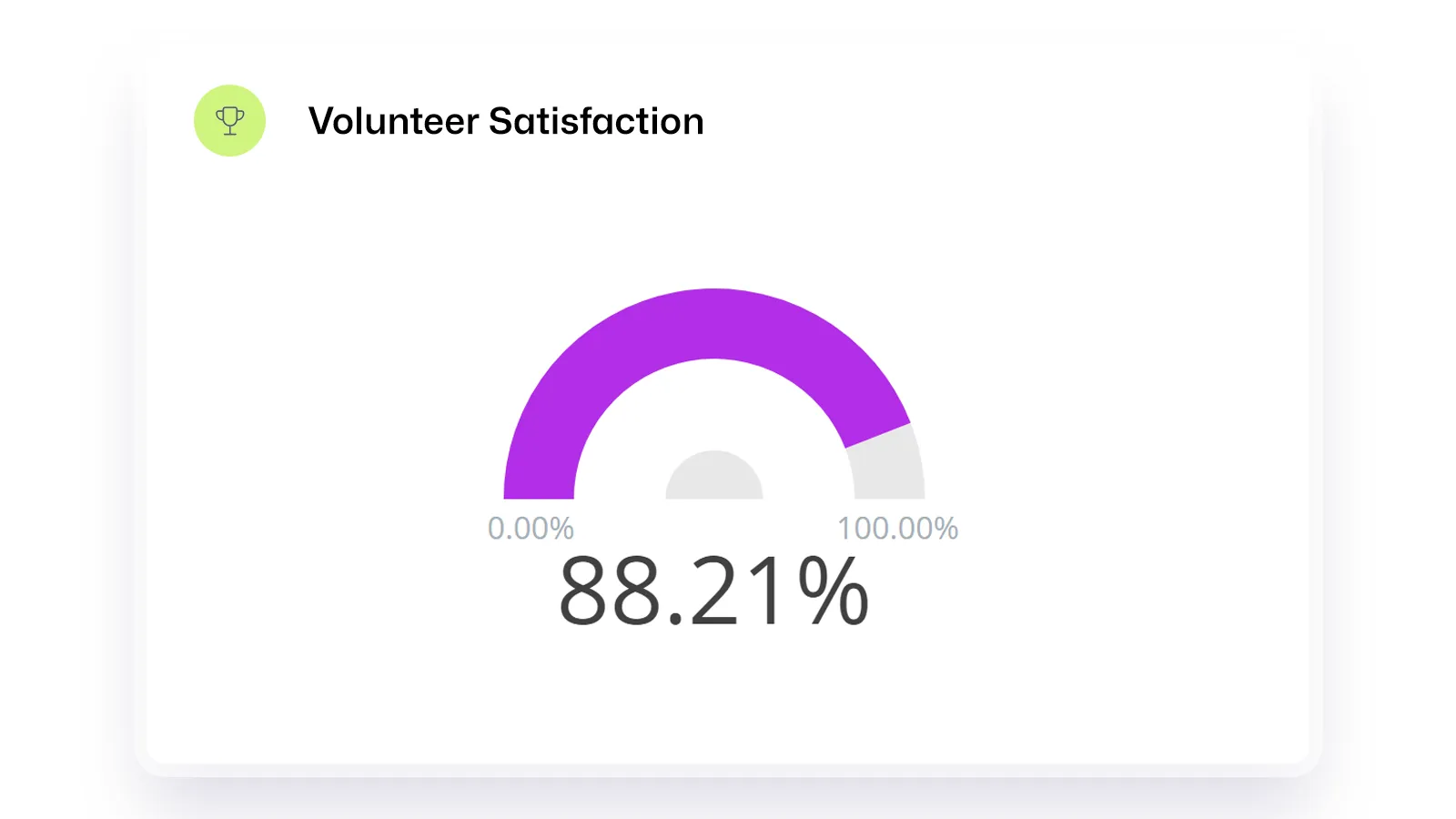
Why track it?
Volunteers really are the heart and soul of non-profit organizations, and keeping them happy is vital to their success. By tracking Volunteer Satisfaction, non-profits can identify areas where they need to enhance their volunteer management efforts. To track Volunteer Satisfaction, non-profits can conduct a Volunteer Satisfaction Survey. This survey can help non-profits identify areas where they need to improve their volunteer management efforts and keep their volunteers engaged and motivated.
The formula is:
Volunteer Satisfaction = (Number of Satisfied Volunteers / Total Number of Volunteers) x 100
Program Efficiency
The percentage of program expenses that go directly to program services. This KPI should be tracked monthly.
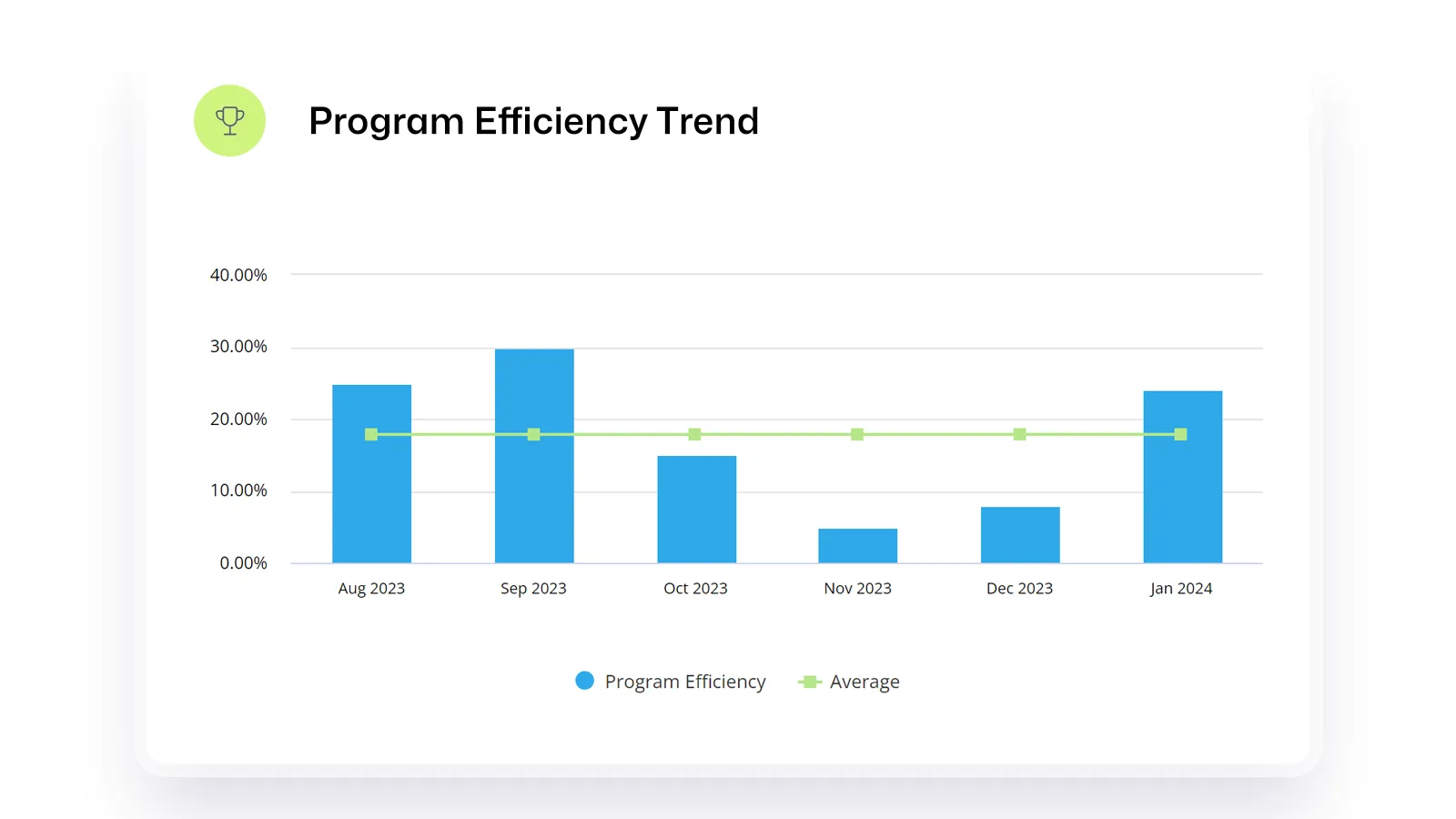
Why track it?
A high Program Efficiency Ratio indicates that the organization uses its resources effectively to attain its mission. By tracking this KPI, non-profits can identify areas where they need to improve their program management efforts. For example, if the Program Efficiency Ratio is low, it could indicate that the organization is spending too much on overhead expenses or that its programs are not being implemented efficiently.
The formula is:
Program Efficiency = (Program Expenses / Total Expenses) x 100
Fundraising Efficiency
The percentage of fundraising expenses that go directly to fundraising activities 4. This KPI should be tracked monthly.
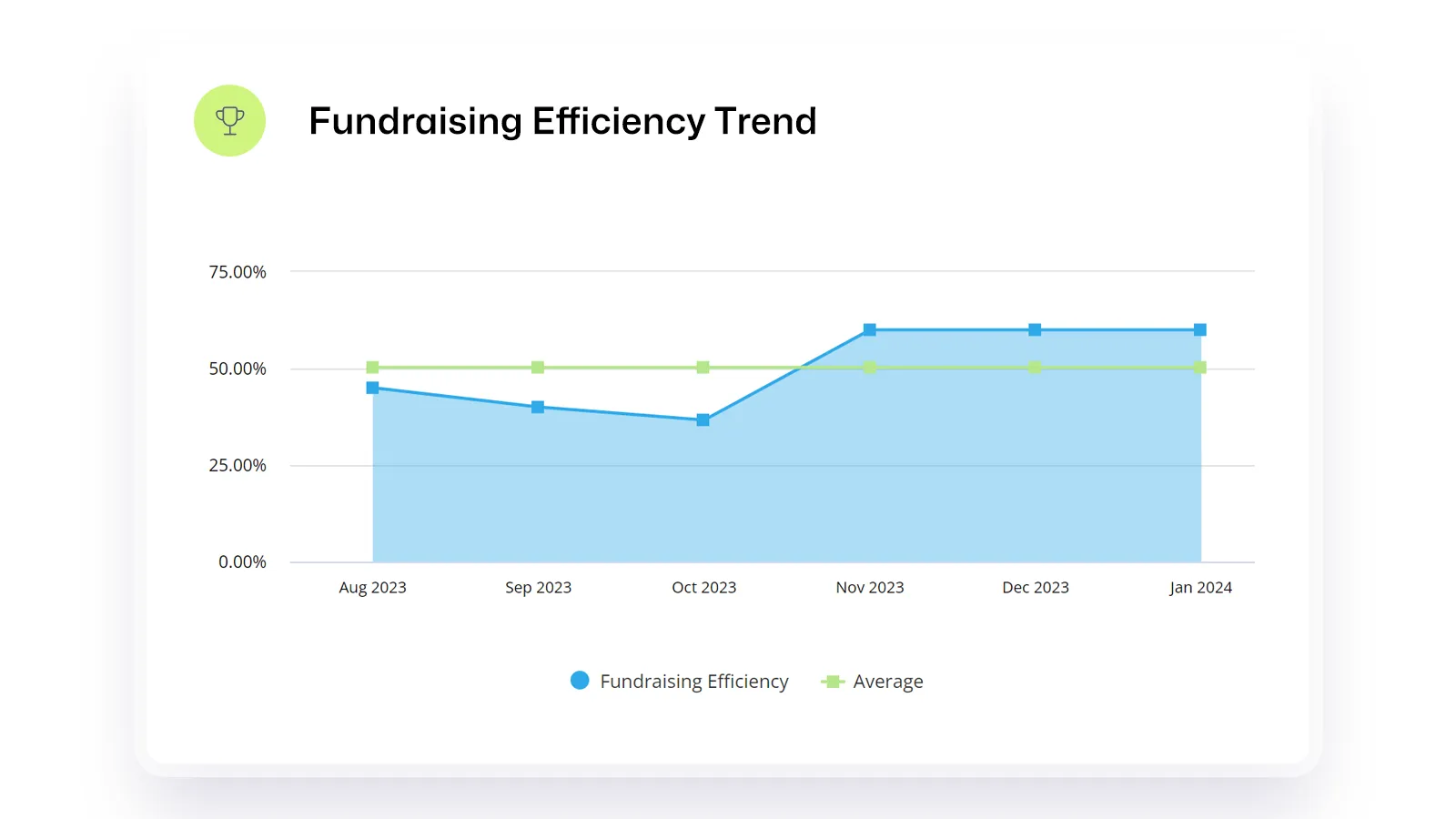
Why track it?
A high Fundraising Efficiency Ratio indicates that the organization uses its resources effectively to raise funds. By tracking this KPI, non-profits can identify areas where they need to improve their fundraising management efforts. For example, if the Fundraising Efficiency Ratio is low, it could indicate that the organization is spending too much on overhead expenses or that its fundraising activities are not being implemented efficiently.
The formula is:
Fundraising Efficiency = (Fundraising Expenses / Total Expenses) x 100
Overhead Rate
The percentage of total expenses that go towards administrative and fundraising expenses. This KPI should be tracked monthly.
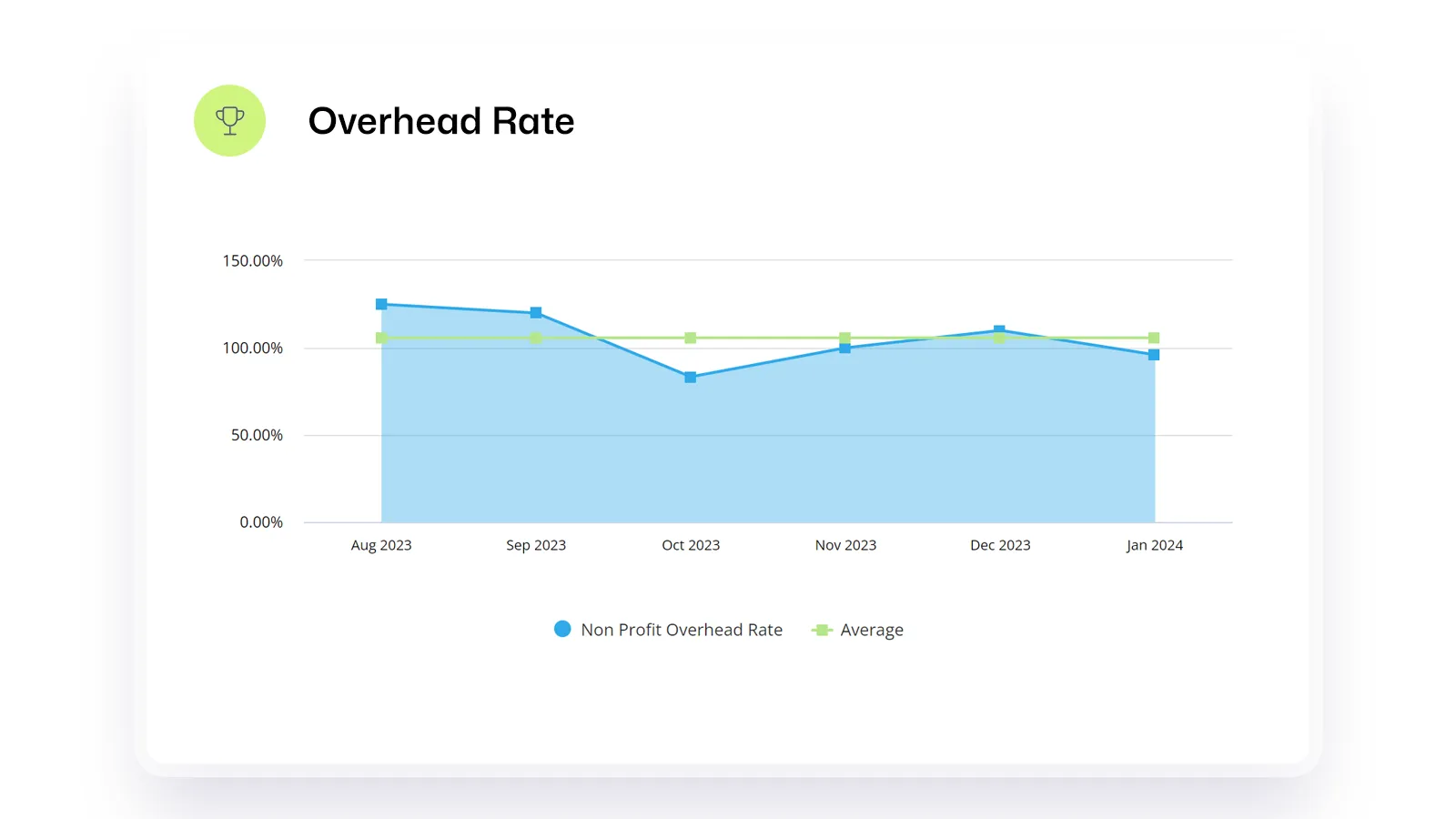
Why track it?
If the Overhead Rate is high, it could mean the organization is spending too much on overhead expenses or its programs are not being implemented efficiently. Non-profits need to keep their overhead expenses low while ensuring they have the resources required to deliver their mission.
The formula is:
Overhead Rate = (Administrative and Fundraising Expenses / Total Expenses) x 100
Social Media Engagement
The number of likes, shares, and comments on your social media posts. This KPI should be tracked weekly. There is no formula for this KPI.
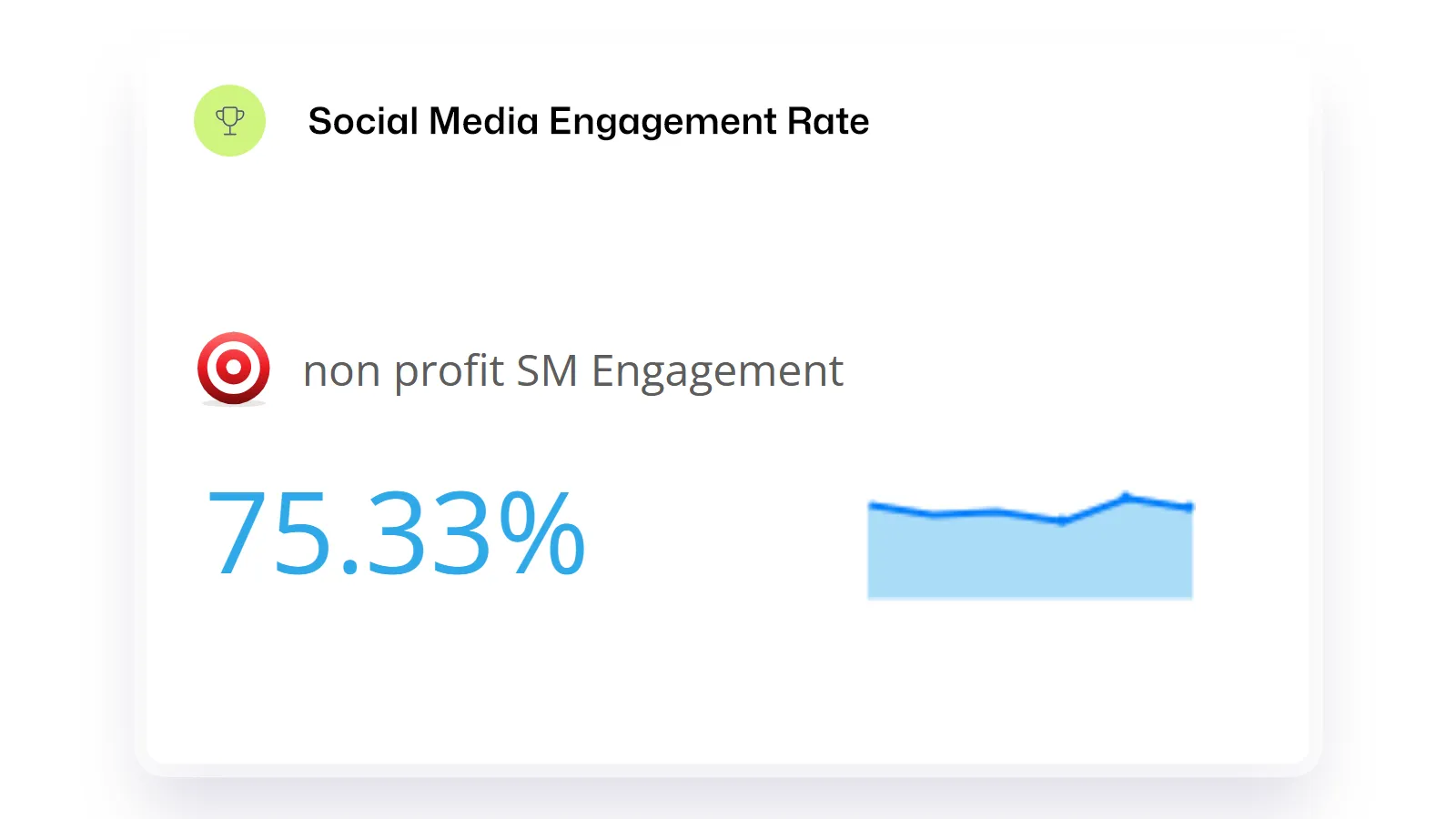
Why track it?
Tracking Social Media Engagement is an essential KPI for non-profits to measure their performance in attracting more donors. Social Media Engagement refers to the degree of interaction users have with your content on social media platforms. It includes likes, comments, shares, and other forms of engagement.
A high Social Media Engagement Rate indicates that the organization is doing an excellent job of reaching out to its audience and building a community around its mission. By tracking this KPI, non-profits can identify areas where they should improve their social media management efforts. For example, if the Social Media Engagement Rate is low, it could indicate that the organization is not creating compelling content or that it is not engaging with its audience effectively.
Who are these non-profit KPIs aimed at?
Advocacy organizations:
Advocacy organizations campaigning for public safety, social welfare, political change, or some other social cause can benefit from KPIs such as donor retention rate, grant applications submitted, and fundraising ROI. These KPIs can help measure the effectiveness of their campaigns and the impact they have on society.
Charitable organizations:
Charitable organizations working to alleviate poverty or provide relief during natural disasters can benefit from KPIs such as cost per service, unit or person served, and maintenance costs. These KPIs can help measure the efficiency of their operations and ensure that they are making the most of their resources.
Educational institutions:
Educational institutions such as acadamies, universities and schools can benefit from KPIs such as student retention rate, graduation rate, and student satisfaction. These KPIs can help measure the effectiveness of their educational programs and ensure that students obtain a quality education.
Environmental groups:
Environmental groups working to protect the planet and its resources can benefit from KPIs such as reducing carbon footprint, waste reduction, and energy consumption reduction. These KPIs can help measure the impact of their efforts on the environment and ensure that they are making a positive difference.
Religious organizations:
Religious organizations dedicated to spreading their faith can benefit from KPIs such as volunteer retention rate, donor retention rate, and fundraising ROI. These KPIs can help measure the effectiveness of their outreach efforts and ensure that they positively impact society.
A non-profit KPI Dashboard to track them all
Time is the greatest enemy of non-profits. It can eat up funding and expertise, leaving them struggling to keep up. So, how can you implement KPIs without creating an administrative overhead?
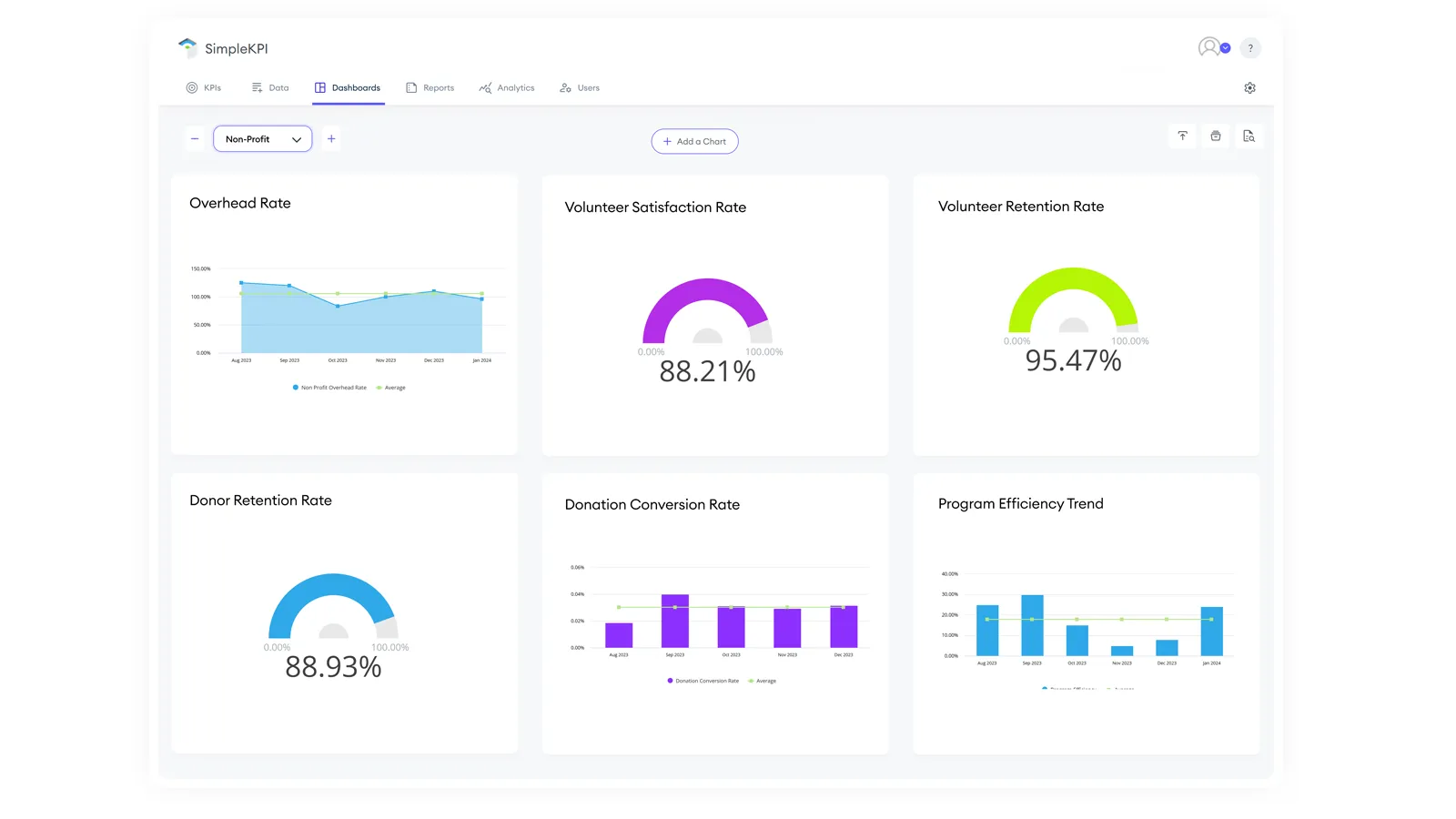
One solution is to use a KPI Dashboard. This is a great, cost-effective, and simple way to visualize KPIs that can be viewed by anyone in the organization at any point in time. KPI Dashboards can be designed to run autonomously and provide easy-to-understand graphs and charts on the non-profit organization's goals of increasing donor and volunteer retention rates and reducing administrative overhead.
You can find an example of a KPI Dashboard Template for non-profit organizations over here.
What are the benefits of non-profits setting up and tracking these KPIs?
Clear Measurement of Progress: One of the benefits of using KPIs in non-profit organizations is the ability to measure your progress toward your mission clearly. KPIs serve as benchmarks, allowing you to evaluate your performance against specific objectives and targets. By defining and tracking these metrics, you can better understand how well you're achieving your goals.
Enhanced Decision-Making: In the ever-changing world of non-profits, it’s important to make informed decisions to ensure efficient resource allocation and optimal outcomes. That’s where KPIs come in! They provide actionable data that informs your decision-making, so you can make strategic choices that align with your mission. By having an understanding of your organization’s performance, strengths, and areas for improvement, you can make data-driven decisions, designed to help you achieve your goals.
Improved AccountabilityNon-profits are accountable to their donors, volunteers, and community. By setting up and tracking KPIs, non-profits can demonstrate their impact and accountability to their stakeholders.
Better Resource Allocation:Non-profits often have limited resources, and allocating them effectively is essential. By tracking KPIs, non-profits can identify areas where they need to allocate more resources and areas where they can reduce costs.
Conclusion
Non-profit organizations face unique challenges in their quest to achieve their societal aims. But don't worry; by leveraging Key Performance Indicators (KPIs), non-profits can streamline their operations, reduce administration time, and stay competitive in this fiercely competitive sector. The eight KPIs that non-profits should track include Donor Retention, Donation Rate, Social Media Engagement, Volunteer Retention, Volunteer Turnover, Overhead, Program Efficiency, and Volunteer Satisfaction. These KPIs are aimed at advocacy groups, charities, educational institutes, environmental organizations, religious groups, and other non-profit organizations. Using a KPI Dashboard; non-profits can track all these KPIs in one place, visualize their progress, and make data driven decisions to enhance their programs, strategically allocate resources, and ultimately achieve their mission. The benefits of non-profit KPIs include improved performance, better decision-making, increased accountability, and enhanced transparency.

by Stuart Kinsey
Stuart Kinsey writes on Key Performance Indicators, Dashboards, Marketing, and Business Strategy. He is a co-founder of SimpleKPI and has worked in creative and analytical services for over 25 years. He believes embracing KPIs and visualizing performance is essential for any organization to thrive and grow.
